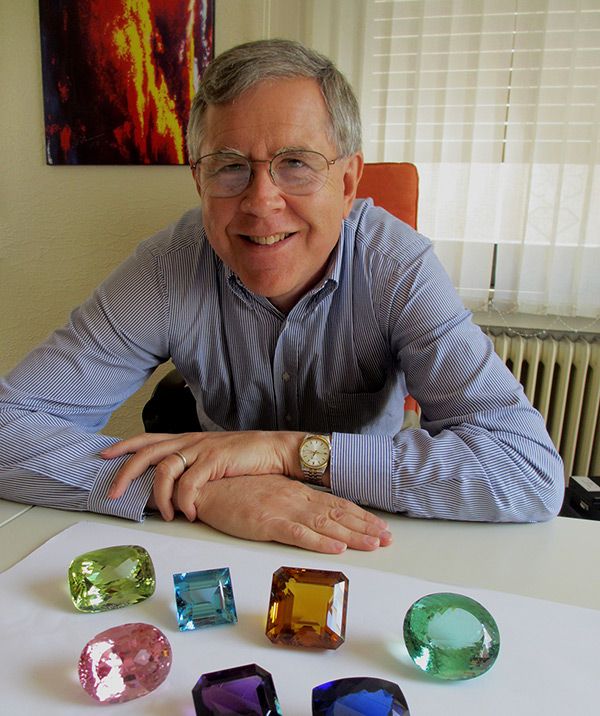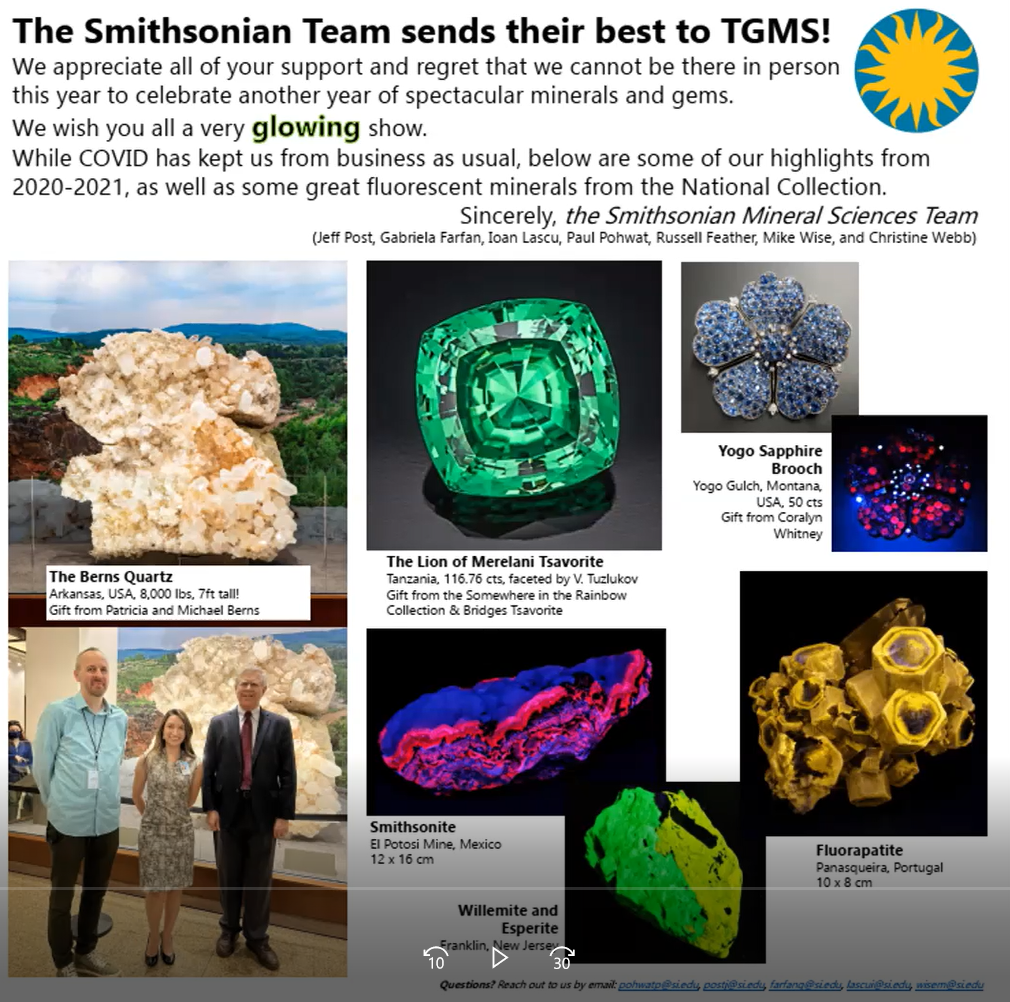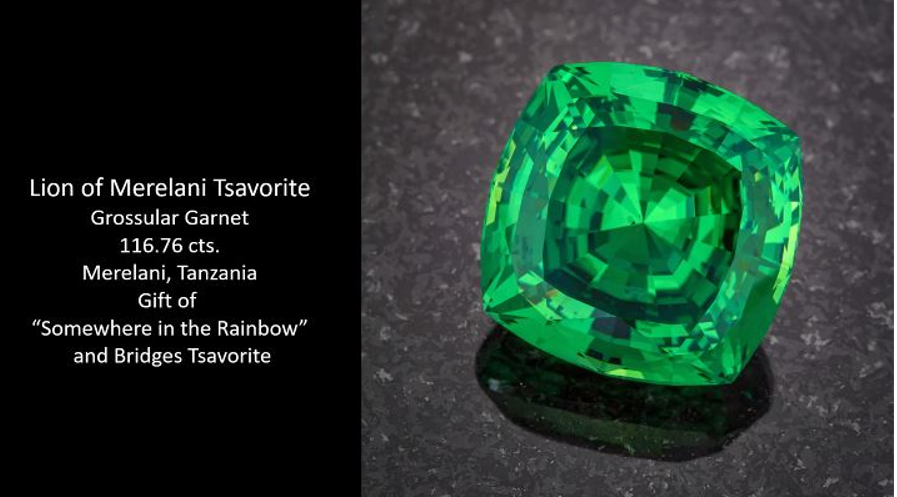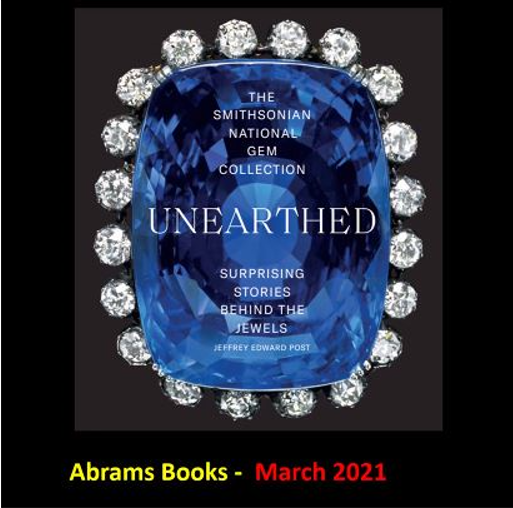Synopsis of the April Program by Dr. Jeffrey Post
Mineralogist and Curator-in-Charge of Gems and Minerals, National Museum of Natural History
Summary by Andy Thompson, MSDC Secretary

Cindy Schmidtlein welcomed Jeff Post who annually provides an update to MSDC, as well as other clubs and benefactors as to the Smithsonian’s recent mineral and gem acquisitions. Time allowing, he also provides updates on new developments and research taking place within the Department of Mineral Sciences.
Dr. Post’s presentation is in high demand and so rooted in his personal experience that there is a strong preference to keep this synopsis brief. This approach will help ensure that future audiences will have the same freshness in his presentation that MSDC was fortunate to experience.
Jeff began by acknowledging that Covid has limited his department’s staff from their normal pathways for finding gem and mineral acquisitions needed to fill in gaps in the Smithsonian’s national collection. As one of the nation’s most prominent mineralogical research facilities, the Smithsonian not only seeks new acquisitions but also provides specimens to museums and universities for their ongoing research programs. The Department also supports mineral clubs in important ways.
The annual Tucson Gem and Mineral Show is a case in point. This past February, due to the ongoing Covid pandemic, the Mineral Sciences Department was not able to send staff, but instead sent a power-packed educational poster (see below). It identified several of the important acquisitions obtained between 2020 and 2021.

The poster showed photos of six gems and minerals as well as stories of their origins.
Those specimens included:
· The Berns Quartz, from Arkansas USA, 8,000 pounds, 7 feet high, Gift of Patricia and Michael Berns
· The Lion of Merelani Tsavorite, from Tanzania, 116.76 carats, a gift of the ”Somewhere in the Rainbow Collection” and Bridges Tsavorite, the company which first starting mining tsavorite
· Yogo Sapphire Brooch, from Yogo Gulch, Montana, 50 carats, a gift of Coralyn Whitney
· Smithsonite, El Potose Mine, Mexico, 12 by 16 cm
· Willemite and Esperite, from Franklin, New Jersey
· Flourapatite, from Panasqueira, Portugal, 10 by 8 cm
In speaking about several of the above specimens, Jeff connected the dots between the geological setting where they were found, who initially owned the minerals, and how each was purchased or came to be donated to the Smithsonian. For the donated specimens, it became clear that there is a web of generous donors who want beautiful gems and minerals to be available to the visitors and researchers associated with the Smithsonian.
What follows is but one example of a donated gemstone, the Lion of Merelani Tsavorite. For the stories about the other minerals on the poster, you will want to watch for an upcoming presentation by Jeff.

The north-east section of Tanzania, close to the border with Kenya, is the location of the Merelani Tsavorite mining operation which recovers spectacular green grossular garnets. The owners of the mine realized this particularly large and clear specimen was, in Jeff’s words, “one of the most spectacular tsavorite stones I have ever seen or know of.” The tsavorite rough was acquired by Bridges Tsavorite in partnership with the “Somewhere in the Rainbow” collection, Jeff said, “who knew this was one of the most spectacular, colored gemstones in the world.” They wanted it to be shared with a wide public. In short, that is how the gemstone came to the collection in the National Museum of Natural History. But there are a lot more interesting facets to the story.
Interestingly, the donors had a special request. They asked that the Smithsonian loan it to the new Tucson Gem and Mineral Museum so it could be displayed during the 2022 February Tucson mineral show, before returning it to the Smithsonian for display in the NMNH. Jeff shared the inside story behind that special request and the peculiar way it was initially delivered to the Natural History Museum.

We hope this snippet of Jeff’s presentation whets your appetite and encourages you to be alert for further stories about the Smithsonian mineral and gem collection, whether you attend presentations by its scientists and researchers or explore its publications, one of which, noted below, was published last year and is full of more of Jeff’s stories. You can find it on Amazon here.
